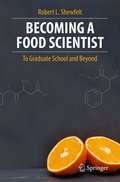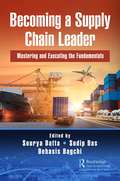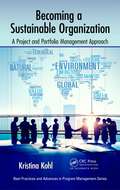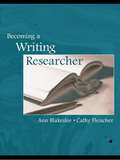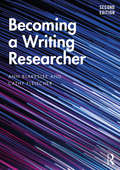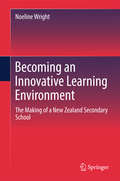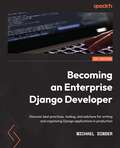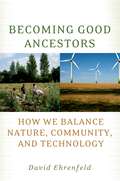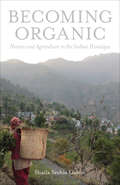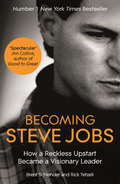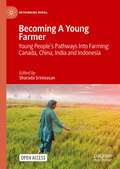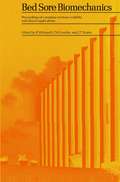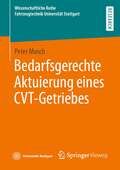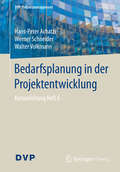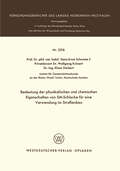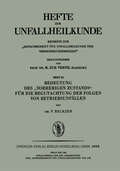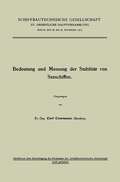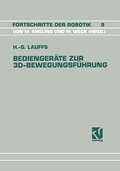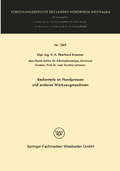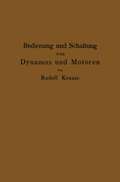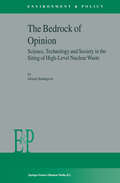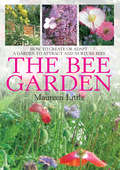- Table View
- List View
Becoming a Food Scientist: To Graduate School and Beyond
by Robert L. ShewfeltBecoming a Food Scientist is designed as a reservoir of ideas for those beginning a graduate education in food science or beginning a professional career in the field. Although at times it may read as a how-to manual for success in graduate school, it is meant to encourage each reader to study the research process, to challenge conventional wisdom, and to develop a career path that maximizes the probability of success both in school and beyond. The author has viewed food science graduate programs through the lenses of programs at four universities and service in numerous activities with the Institute of Food Technologists. This book is thus focused on the field of food science, but it may have relevance to other scientific disciplines. The book introduces the concept of research as process in the first chapter. Subsequent chapters focus on individual unit operations of research: idea generation, problem definition, critical evaluation of the literature, method selection, experimental design, data collection, processing and analysis, and knowledge dissemination. Successful graduate students in food science must master each of these operations. The final section of the book pushes the reader beyond graduate school into its practice in the real world. Topics covered in the maturation of a food scientist include the scientific meeting, critical thinking, science and philosophy, ethics, finding and managing the literature, planning, grantsmanship, laboratory setup and management, and career development. This book should be a meaningful companion for any graduate student in the field and those transitioning from graduate school to the food science profession.
Becoming a Supply Chain Leader: Mastering and Executing the Fundamentals
by Sourya DattaThe book explains how to emerge and grow as a supply chain leader and details supply chain and procurement processes and operational activities in real-work scenarios across multiple supply chain verticals. The book defines what an entry-level supply chain professional must do to excel in various types of supply chain verticals such as IT, electronics manufacturing, pharmaceutical, retail, and consumer goods. Apart from helping professionals understand vertical specific nuances, this book helps them to set both short-term goals for annual performance review and longer-term career planning. In addition, for a mid- or senior-level supply chain professional, the book offers ideas on ways to launch initiatives and demonstrate leadership to foster career growth. It offers ideas about unlocking new values for the organization and creating a data-driven decision support platform to gain financial efficiency for better management of CapEx and OpEx spend, thus improving the bottom line. The book includes a tool kit which includes operational data models, financial models, and presentation templates for creating and socializing proposals intended for cross-functional teams and demonstrating supply chain leadership. The book is divided into four major parts. In Part I, the book starts with an overview of key concepts in a manufacturing supply chain and procurement organization. It describes current forms of modern global supply chain and corporate procurement organizations. The objective of Part II is to provide a framework for a self-directed supply chain manager to understand how a large organization evaluates the contribution of supply chain managers and where it expects them to create value. To foster career growth as a supply chain professional, the book identifies six key knowledge pillars for demonstrating supply chain mastery: Technical and market knowledge of the end product and its constituents. Knowledge of internal product development and sustaining processes and supporting consumption data. Health and market condition of the supplier. Ability to create value. Ability to build internal and external executive relationships with key influencers. Ability to obtain best cost without compromising on quality and lead time. Negotiating cost, sourcing material, and then the logistics of moving the raw material through multiple stages and finally finished materials across the globe are some of the key areas which need continuous improvement. As a sentinel of efficiency, removing any kind of wastage leads to immediate value creation and contributes to the margin by improving the bottom line. In Part III, the book reviews twelve such verticals namely printer, medical, IT, energy, automotive, cloud, dairy, data management, avionics, biotech, apparel and start up and the supply chain nuances through the lenses of the framework created in Part II. In Part IV, the book goes back to focus on the professional growth of an individual supply chain person in an industry agnostic way. It provides examples of financial and operational efficiencies that a supply chain professional can create.
Becoming a Supply Chain Leader: Mastering and Executing the Fundamentals
by Sourya Datta Sudip Das Debasis BagchiThe book explains how to emerge and grow as a supply chain leader and details supply chain and procurement processes and operational activities in real-work scenarios across multiple supply chain verticals. The book defines what an entry-level supply chain professional must do to excel in various types of supply chain verticals such as IT, electronics manufacturing, pharmaceutical, retail, and consumer goods. Apart from helping professionals understand vertical specific nuances, this book helps them to set both short-term goals for annual performance review and longer-term career planning. In addition, for a mid- or senior-level supply chain professional, the book offers ideas on ways to launch initiatives and demonstrate leadership to foster career growth. It offers ideas about unlocking new values for the organization and creating a data-driven decision support platform to gain financial efficiency for better management of CapEx and OpEx spend, thus improving the bottom line. The book includes a tool kit which includes operational data models, financial models, and presentation templates for creating and socializing proposals intended for cross-functional teams and demonstrating supply chain leadership. The book is divided into four major parts. In Part I, the book starts with an overview of key concepts in a manufacturing supply chain and procurement organization. It describes current forms of modern global supply chain and corporate procurement organizations. The objective of Part II is to provide a framework for a self-directed supply chain manager to understand how a large organization evaluates the contribution of supply chain managers and where it expects them to create value. To foster career growth as a supply chain professional, the book identifies six key knowledge pillars for demonstrating supply chain mastery: Technical and market knowledge of the end product and its constituents. Knowledge of internal product development and sustaining processes and supporting consumption data. Health and market condition of the supplier. Ability to create value. Ability to build internal and external executive relationships with key influencers. Ability to obtain best cost without compromising on quality and lead time. Negotiating cost, sourcing material, and then the logistics of moving the raw material through multiple stages and finally finished materials across the globe are some of the key areas which need continuous improvement. As a sentinel of efficiency, removing any kind of wastage leads to immediate value creation and contributes to the margin by improving the bottom line. In Part III, the book reviews twelve such verticals namely printer, medical, IT, energy, automotive, cloud, dairy, data management, avionics, biotech, apparel and start up and the supply chain nuances through the lenses of the framework created in Part II. In Part IV, the book goes back to focus on the professional growth of an individual supply chain person in an industry agnostic way. It provides examples of financial and operational efficiencies that a supply chain professional can create.
Becoming a Sustainable Organization: A Project and Portfolio Management Approach (Best Practices And Advances In Program Management Ser.)
by Kristina KohlOrganizations find that a performance gap exists between sustainability vision and benefits realization. Effecting transformational change requires incorporating sustainability into organization's culture including policies, processes, and people. Although they are often overlooked, project management professionals and HR professionals are valuable
Becoming a Writing Researcher
by Ann M. Blakeslee Cathy FleischerBecoming a Writing Researcher effectively guides students through the stages of conducting qualitative writing research, from the initial step of seeing themselves as researchers, to identifying research questions, selecting appropriate tools, conducting the research, and interpreting and reporting the findings. Authors Ann M. Blakeslee and Cathy Fleischer describe various qualitative methods and provide readers with examples of real-world applications. Exercises and activities, as well as anecdotes from both novice and seasoned researchers, serve to acquaint readers thoroughly with the practice of carrying out research for scholarly or professional purposes. The textbook introduces students to research methods in a gradual and contextualized manner. Each chapter opens with a discussion of general issues regarding a particular portion of the research process, followed by a consideration of the various physical, conceptual, and strategic tools that allow a beginning researcher to conduct that part of the process. Sections within each chapter also cover: personal and theoretical perspectives and biases that influence specific stages of the research process ethical issues associated with phases of the research process the identity, ethos, and experiences of the researcher. Becoming a Writing Researcher is an essential text for all novice researchers, and is well suited for use in graduate-level research methods courses in composition and technical communication. It is also ideal for use in other disciplines with strong qualitative methodology research programs, including education.
Becoming a Writing Researcher
by Ann M. Blakeslee Cathy FleischerBecoming a Writing Researcher effectively guides students through the stages of conducting qualitative writing research, from the initial step of seeing themselves as researchers, to identifying research questions, selecting appropriate tools, conducting the research, and interpreting and reporting the findings. Authors Ann M. Blakeslee and Cathy Fleischer describe various qualitative methods and provide readers with examples of real-world applications. Exercises and activities, as well as anecdotes from both novice and seasoned researchers, serve to acquaint readers thoroughly with the practice of carrying out research for scholarly or professional purposes. The textbook introduces students to research methods in a gradual and contextualized manner. Each chapter opens with a discussion of general issues regarding a particular portion of the research process, followed by a consideration of the various physical, conceptual, and strategic tools that allow a beginning researcher to conduct that part of the process. Sections within each chapter also cover: personal and theoretical perspectives and biases that influence specific stages of the research process ethical issues associated with phases of the research process the identity, ethos, and experiences of the researcher. Becoming a Writing Researcher is an essential text for all novice researchers, and is well suited for use in graduate-level research methods courses in composition and technical communication. It is also ideal for use in other disciplines with strong qualitative methodology research programs, including education.
Becoming a Writing Researcher
by Cathy Fleischer Ann BlakesleeBecoming a Writing Researcher effectively guides students through the stages of conducting qualitative writing research, from the initial step of seeing themselves as researchers, to identifying research questions, selecting appropriate methodological tools, conducting the research, and interpreting and reporting findings. Exercises and activities, as well as anecdotes and examples from both novice and seasoned researchers, serve to acquaint readers thoroughly with the practice of carrying out research for scholarly or professional purposes. This second edition introduces students to research methods in a gradual and contextualized manner. Each chapter offers a discussion of a particular portion of the research process, followed by consideration of physical, conceptual, and strategic tools that allow a master’s level researcher to conduct that part of the research. Sections within each chapter also cover issues of stance and positionality that impact the researcher and the resulting research. Becoming a Writing Researcher, second edition, is an essential text for all novice researchers and is particularly well suited for use in graduate-level research methods courses in writing studies and technical communications. It is also ideal for use in other disciplines with strong qualitative methodology research programs, including education.
Becoming a Writing Researcher
by Cathy Fleischer Ann BlakesleeBecoming a Writing Researcher effectively guides students through the stages of conducting qualitative writing research, from the initial step of seeing themselves as researchers, to identifying research questions, selecting appropriate methodological tools, conducting the research, and interpreting and reporting findings. Exercises and activities, as well as anecdotes and examples from both novice and seasoned researchers, serve to acquaint readers thoroughly with the practice of carrying out research for scholarly or professional purposes. This second edition introduces students to research methods in a gradual and contextualized manner. Each chapter offers a discussion of a particular portion of the research process, followed by consideration of physical, conceptual, and strategic tools that allow a master’s level researcher to conduct that part of the research. Sections within each chapter also cover issues of stance and positionality that impact the researcher and the resulting research. Becoming a Writing Researcher, second edition, is an essential text for all novice researchers and is particularly well suited for use in graduate-level research methods courses in writing studies and technical communications. It is also ideal for use in other disciplines with strong qualitative methodology research programs, including education.
Becoming an Innovative Learning Environment: The Making of a New Zealand Secondary School
by Noeline WrightThis book traces how a new school, physically designed as a modern learning environment, has come into being in New Zealand. A key feature is how it designs its curriculum for future citizens. The book explores how flexible curriculum and assessment options support the provision of a well-balanced, coherent and future-oriented learning programme. It also illustrates how the school is implementing its vision and copes with being different from other schools which understand and embody the New Zealand Curriculum as well as the NCEA qualifications system in more traditional terms. School leaders’, teachers’ and foundation students’ thinking and perspectives about what it’s like to become a new school are highlighted and shed light on what is possible within an evolving education system.
Becoming An Enterprise Django Developer: Discover Best Practices, Tooling, And Solutions For Writing And Organizing Django Applications In Production
by Michael DinderDiscover best practices, tooling, and solutions for writing and organizing Django applications in production
Becoming Good Ancestors: How We Balance Nature, Community, and Technology
by David EhrenfeldA brilliant writer and gifted "big picture" thinker, David Ehrenfeld is one of America's leading conservation biologists. Becoming Good Ancestors unites in a single, up-to-date framework pieces written over two decades, spanning politics, ecology, and culture, and illuminating the forces in modern society that thwart our efforts to solve today's hard questions about society and the environment. The book focuses on our present-day retreat from reality, our alienation from nature, our unthinking acceptance of new technology and rejection of the old, the loss of our ability to discriminate between events we can control and those we cannot, the denial of non-economic values, and the decline of local communities. If we are aware of what we are losing and why we are losing it, the author notes, all of these patterns are reversible. Through down-to-earth examples, ranging from a family canoe trip in the wilderness to the novels of Jane Austen to Chinese turtle and tiger farms, Ehrenfeld shows how we can use what we learn to move ourselves and our society towards a more stable, less frantic, and far more satisfying life, a life in which we are no longer compelled to damage ourselves and our environment, in which our children have a future, and in which fewer species are endangered and more rivers run clean. In the final chapter, he offers a dramatic view of the possibilities inherent in a fusion of the best elements of conservatism and liberalism. Our society has an inherent sense of what is right, says Ehrenfeld, and the creativity and persistence to make good things happen. It is now time to apply our intelligence, guided by our moral judgment, to the very large problems we all face. This book is an important first step.
Becoming Organic: Nature and Agriculture in the Indian Himalaya (Yale Agrarian Studies Series)
by Shaila Seshia GalvinA rich, original study of the social and bureaucratic life of organic quality that challenges assumptions of what organic means Tracing the social and bureaucratic life of organic quality, this book yields new understandings of this fraught concept. Shaila Seshia Galvin examines certified organic agriculture in India’s central Himalayas, revealing how organic is less a material property of land or its produce than a quality produced in discursive, regulatory, and affective registers. Becoming Organic is a nuanced account of development practice in rural India, as it has unfolded through complex relationships forged among state authorities, private corporations, and new agrarian intermediaries.
Becoming Steve Jobs: The evolution of a reckless upstart into a visionary leader
by Brent Schlender Rick TetzeliTHE SUNDAY TIMES AND #1 INTERNATIONAL BESTSELLER - with a new foreword by Silicon Valley legend Marc Andreessen.'For my money, a better book about Jobs than Walter Isaacson's biography' New Yorker'A fascinating reinterpretation of the Steve Jobs story' Sunday TimesWe all think we know who Steve Jobs was, what made him tick, and what made him succeed. Yet the single most important question about him has never been answered. The young, impulsive, egotistical genius was ousted in the mid-80s from the company he founded, exiled from his own kingdom and cast into the wilderness. Yet he returned a decade later to transform the ailing Apple into the most successful company the world had ever seen. How did this reckless upstart transform himself into a visionary business leader? The first comprehensive study of Jobs' career following his dismissal from Apple, written with unparalleled access and insight, BECOMING STEVE JOBS offers a startling new portrait of the most important business figure in modern history. The most intimate biography yet of Jobs, written by the journalist who knew him better than any other, BECOMING STEVE JOBS draws on recently discovered interviews that have never before seen the light of day, and answers for the first time the most pressing questions about what made this legendary business leader such a success.'Brent Schlender and Rick Tetzeli render a spectacular service with this book, giving fresh perspective onSteve Jobs' journey from inspiring but immature entrepreneur into an inspired and mature company-builder. Most important, they capture Jobs' resilience, his refusal to capitulate, his restless drive to stay in the game, his voracious appetite to learn-this, far more than genius, is what made him great.Becoming Steve Jobs gets the focus precisely right: not as a success story, but as a growth story. Riveting, insightful, uplifting-read it and learn!' Jim Collins, author of Good to Great'BECOMING STEVE JOBS is fantastic. After working with Steve for over 25 years, I feel this book captures with great insight the growth and complexity of a truly extraordinary person. I hope that it will be recognized as the definitive history.' Ed Catmull, President, Pixar and Disney Animation
Becoming A Young Farmer: Young People’s Pathways Into Farming: Canada, China, India and Indonesia (Rethinking Rural)
by Sharada SrinivasanThis open access book is based on a multi-country collaborative research project focussing on Canada, China, India, and Indonesia.It responds directly and concretely to concerns about the generational sustainability of smallholder farming worldwide– reflected in the current UN Decade of Family Farming. Drawing on research that asks how (some) young people continue to pursue a (future) livelihood in farming, the book uses the life-course perspective and privileges voices of young farmers to show that movement away from farming such as time spent in education, migration and non-farm work does not exclude eventual farming futures.The book will be of interest to scholars and students of agrarian studies, anthropology, development studies, gender studies, human geography, rural sociology, and youth studies.
Bedarfsgerechte Aktuierung eines CVT-Getriebes (Wissenschaftliche Reihe Fahrzeugtechnik Universität Stuttgart)
by Peter MuschPeter Musch stellt zwei verschiedene Konzepte zur bedarfsgerechten Aktuierung von CVT-Getrieben vor. Dabei werden verschiedene Betriebsstrategien der Konzepte und ihr Einfluss auf den Getriebewirkungsgrad mittels validierten Simulationsmodellen untersucht. Auslegung und Konstruktion der einzelnen Komponenten werden detailliert beschrieben und Ergebnisse der Prüfstandsversuche vorgestellt. Die Reduzierung der Aktuierungsenergie kann durch den verbesserten Wirkungsgrad so einen signifikanten Beitrag zum verminderten Flottenverbrauch leisten. Zudem ermöglichen die Konzepte die Realisierung von Hybridfunktionen wie Stopp-Start und Segel.
Bedarfsplanung in der Projektentwicklung: Kurzanleitung Heft 6 (DVP Projektmanagement)
by Hans-Peter Achatzi Werner Schneider Walter VolkmannDas Buch ist ein kompakter Leitfaden zur schrittweisen Erarbeitung der Bedarfsplanung von Hochbauaufgaben. Großprojekte stehen durch Budget- und Terminüberschreitungen zu Recht in der Kritik der Öffentlichkeit. Doch sie sind nur die Spitze des Eisbergs. Auch bei weniger spektakulären Projekten werden Ziele immer wieder verfehlt. Oft werden sie teurer, später fertig und erreichen nicht die erwartete Qualität. Die Fachwelt ist sich einig, dass die entscheidenden Fehler in der ersten Phase eines Projektes gemacht werden, und zwar in der Erarbeitung und Abstimmung der qualitativen und quantitativen Anforderungen. Auch die vom Bundesministerium für Verkehr und digitale Infrastruktur einberufene „Reformkommission Bau von Großprojekten“ hebt die Bedeutung der ersten Schritte in einem Bauprojekt hervor.
Bedeutung der physikalischen und chemischen Eigenschaften von SM-Schlacke für eine Verwendung im Straßenbau (Forschungsberichte des Landes Nordrhein-Westfalen)
by Hans-Ernst SchwieteBedeutung des „Vorherigen Zustands“ für die Begutachtung der Folgen von Betriebsunfällen (Hefte zur Unfallheilkunde)
by P. ReckzehDieser Buchtitel ist Teil des Digitalisierungsprojekts Springer Book Archives mit Publikationen, die seit den Anfängen des Verlags von 1842 erschienen sind. Der Verlag stellt mit diesem Archiv Quellen für die historische wie auch die disziplingeschichtliche Forschung zur Verfügung, die jeweils im historischen Kontext betrachtet werden müssen. Dieser Titel erschien in der Zeit vor 1945 und wird daher in seiner zeittypischen politisch-ideologischen Ausrichtung vom Verlag nicht beworben.
Bedeutung und Messung der Stabilität von Seeschiffen
by Carl CommentzDieser Buchtitel ist Teil des Digitalisierungsprojekts Springer Book Archives mit Publikationen, die seit den Anfängen des Verlags von 1842 erschienen sind. Der Verlag stellt mit diesem Archiv Quellen für die historische wie auch die disziplingeschichtliche Forschung zur Verfügung, die jeweils im historischen Kontext betrachtet werden müssen. Dieser Titel erschien in der Zeit vor 1945 und wird daher in seiner zeittypischen politisch-ideologischen Ausrichtung vom Verlag nicht beworben.
Bediengeräte zur 3D-Bewegungsführung: Ein Beitrag zur effizienten Roboterprogrammierung (Fortschritte der Robotik #9)
by Hans-Georg LauffsBedienteile an Handpressen und anderen Werkzeugmaschinen (Forschungsberichte des Landes Nordrhein-Westfalen #1269)
by Henning WodeÜber die zweckmäßige Art und günstige räumliche Anordnung von Bedienteilen - wie Handräder, Kurbeln und Hebel-gibt es eine umfangreiche Literatur. Sie ist jedoch fast ausnahmslos beschränkt auf folgende Anwendungsfälle : 1. a) Einstellen eines mit dem Bedienteil gekoppelten Zeigers auf eine gewünschte Lage. b) Nachfahren einer sich bewegenden Marke mit einem Zeiger, der mit dem Bedienteil gekoppelt ist. c) Fälle a) und b) jeweils bei einer Teil- oder vollen Umdrehung oder bei meh reren Umdrehungen des Bedienteils ; bei unterschiedlichen Drehwider ständen. 2. a) Einleitung eines möglichst großen Energiebetrages in das Bedienteil bei einer Umdrehung oder mehreren aufeinanderfolgenden Umdrehungen des Bedienteiles. b) Einleiten eines möglichst großen statischen Drehmomentes oder einer mög lichst großen Kraft in das ganz oder nahezu feststehende Bedienteil. Anscheinend fehlen aber noch Untersuchungen über die zweckmäßige Art und Lage von Bedienteilen, an denen vom Menschen Arbeit geleistet werden soll, in 0 dem er sie um weniger als 360 wiederholt gegen einen Arbeitswiderstand hin bewegt und unbelastet zurückbewegt. Da solche Arbeitsbedingungen in der Praxis häufig vorkommen - wie u. a. in diesem Bericht nachgewiesen wird -, ist eine Untersuchung hierüber angebracht. Um Klarheit für den folgenden Bericht zu schaffen, müssen zunächst einige De finitionen gegeben werden: »Handpresse« ist eine Presse, deren für den Arbeitsvorgang notwendige Energie vom Menschen über seine Hand in sie eingeleitet wird. Die Energiezufuhr durch den Menschen erfolgt über das »Bedienteil« : »Bedienteil« ist das Bauteil, über das ein Mensch auf eine Vorrichtung die für die Arbeitsaufgabe nötige Energie überträgt.
Bedienung und Schaltung von Dynamos und Motoren sowie für kleine Anlagen ohne und mit Akkumulatoren
by Rudolf KrauseThe Bedrock of Opinion: Science, Technology and Society in the Siting of High-Level Nuclear Waste (Environment & Policy #32)
by G. SundqvistWhen did man discover nuclear waste? To answer this question, we first have to ask if nuclear waste really is something that could be called a scientific discovery, such as might deserve a Nobel Prize in physics. In early writings within nuclear energy research radioactive waste appears to be a neglected issue, a story never told. Nuclear waste first seems to appear when a public debate arose about public health risks of nuclear power in the late 1960s and early 70s. In nuclear physics, consensus was established at an early stage about the understanding of the splitting of uranium nuclei. The fission products were identified and their chains of disintegration and radioactivity soon were well established facts among the involved scientists, as was an awareness of the risks, for example the strong radioactivity of strontium and iodine, and the poisonous effects of plutonium. However, the by-products were never, either in part or in total, called or perceived as waste, just as fission by-products. How and where to dispose of the by-products were questions that were never asked by the pioneers of nuclear physics.
The Bee Garden: How to Create or Adapt a Garden to Attract and Nurture Bees
by Maureen LittleBees play a vital and irreplaceable role in pollinating our flowers, fruits and vegetables. The more bees in your garden the healthier, more productive and more pleasant a place it will be. Yet bees are declining rapidly and many people, even if they do not wish to keep bees themselves, are asking what can be done on an individual basis to help the bee. This book is a response to that request. It will demonstrate in one accessible volume how each of us can play our part in providing a bee-friendly environment, no matter how much gardening space and/or time we may have. It includes: * How bees forage, what bees you can expect to find in your garden and what plants are best for them. * Why honey bees are so important; what they need to thrive and how they detect and access those requirements; and what varieties of plants are best suited to provide those needs. * How the gardener can offer and maintain a bee-friendly garden, followed by a season-by-season account of what beefriendly plants are in flower and when, and what jobs the gardener can be doing during these times to help bees thrive. * A gazetteer of selected bee-friendly plants, arranged by type of plant in seasonal sub-sections. * Illustrative, practical planting plans, including a culinary herb garden, a potager, a wild flower garden, and a 3 seasons traditional border.
